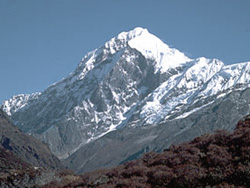| Destinations
|
|||
Entry Formalities
Indians only need permits to enter the restricted areas or the inner line permit areas. Indians travelling in Sikkim would be advised to carry either passport, drivers license or election voting card or ration card. It is generally not required, because Indians do not need permits to enter Sikkim. But identification documents proving your Indian identity may be needed. An NRI holding a valid Indian passport is also allowed. Foreigners need a permit to enter Sikkim. Indians with foreign passport also need permits. For the following restricted areas Indians need Inner Line Permits (ILP): a) North Sikkim: Chungthang, Lachung, Yumthang Valley, Yumesamdong, Lachen, Thangu, Chopta and Gurudongmar Lake. b) East Sikkim: Tsongo Lake, Nathula Pass, Kupup and Menmecho Lake. The ILP can be obtained from Sikkim Police, Gangtok. Any reputed travel agent will also organise the same for you. For Nathula Pass, Kupup and Menmecho Lake, small groups are now permitted to visit these areas with special permits from the Army. Foreign nationals would require a restricted area permit to visit areas that are unrestricted for Indian Nationals. Foreign Nationals are permitted to visit Gangtok, Rumtek, Phodong and Pemayangtse on the basis of a 15 day visa. A special endorsement allows access to areas around Pemayangste. A 15 day visa-extension is available in Gangtok from the Home Office, Tashiling Secretariat. |
More about Sikkim • An Overview • Geography • History • People & Culture • Economy • Festivals • Off the Beaten Track • Wild Life • Adventure • Monastery Magic • Gangtok • Accommodation • Getting There • Climate • FAQ
Travelogues
Trekking
| ||
Foreigners are allowed a day visit to Tsongo lake provided they are in groups of four or more. They are also permitted to trek to the Dzongri area and to Yumthang valley and Lachen provided they are in a group of four or more and are doing the trek through a recognized travel agency. Permits can be obtained from the Foreigners Regional Registration Offices at Delhi, Mumbai, Calcutta and Darjeeling as well as from the Sikkim Tourism Information Centre in Calcutta and Siliguri. Best Time to Visit There are 3 seasons for visiting Sikkim. a) Summer: Summer is from mid-April till the end of May after which the monsoons break at the beginning of June. This is the time when the rhododendrons are in full bloom in places like Yumthang, Varshey (West Sikkim-2 day trek) etc. The skies are fairly clear with occasional showers. This is one of the best times to go on treks.
c) Winters: This is the season for those who dare. A visit to Yumthang Valley in winters offers an awesome panorama of a wilderness under a sheet of snow. Tsongo Lake is frozen solid and remains that way till Feb-March. Even in early April one can frolic in the ice in Yumthang and Tsongo, although it doesn't normally snow there in April. But be warned, it's really cold out there! Note: Avoid visiting Sikkim from mid-June to 10th September due to heavy rains and occasional landslides. However, the high rates of discounts offered by hotels and the sparse crowd in the monsoons are incentive enough for the intrepid traveler. Sikkim is a landslide prone area and in the monsoons many parts of Sikkim are cut off. The repairs are taken care of by the Border Roads Organisation (BRO), who do a great job of clearing the roads as fast as possible. With the border close by, it is also imperative from the defence point of view to keep the roads as clear as possible.`Transhipments' across landslides are common and can be an adventurous experience! Shopping First and foremost are the handicrafts. Reliable shops are the Govt. Institute of Cottage Industry in Gangtok or the Dalai Lama Trust Fund shop in the basement of Hotel Tibet. These are also available in other shops, but shop around for an idea of prices. You can check out the canvas wall hangings, thankas, prayer wheels, Tibetan carpets, rugs and jewellery, particularly the exquisitively carved dragon sets in silver and gold inlaid with precious stones, which are unique to Sikkim. Sikkim tea and cardamom are other good buys. Compiled by Romola Butalia
|
|||
Editor: Romola Butalia (c) India Travelogue. All rights reserved. |
|||

 b) Autumn: This is a great season when the skies are clear and the mountains are preparing for the winter months ahead. The snow clad peaks should now be visible with the air at its cleanest after 4 months of torrential rains.
b) Autumn: This is a great season when the skies are clear and the mountains are preparing for the winter months ahead. The snow clad peaks should now be visible with the air at its cleanest after 4 months of torrential rains.